[Note: All images were current as of 23 January 2016 at 11: 30 pm central time.]
I’ve had a little time to work with the “U.S., Obituary Collection, 1930 – 2015” at Ancestry.com. And I’m not impressed.
Complaint number one: What paper was the obituary in?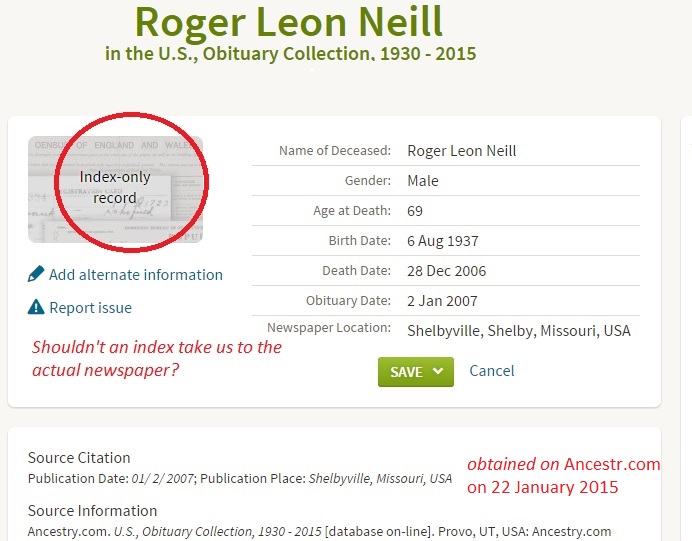
The specific newspaper from which the obituary “index” information was taken is not included in what Ancestry.com calls the “record.” In some cases, the name of town where the newspaper was published is indicated. In other cases it is not. An “index” should lead the researcher to the actual entry from which the index information was extrapolated. This database does not do that.
How difficult is it to harvest the name of the newspaper when harvests information from the obituary?
Complaint number two: Grabbing any state or county for a place name
Poor geographic “plucking” is another criticism of this database. This is what happens when instead of just extracting data from a published item, the search algorithm apparently generates missing information. The location of Quincy is likely mentioned in the obituary of my great-aunt, Mildred (Irvin) Trautvetter as illustrated in the second image. The database “index” entry concluded that it must be Quincy, Massachusetts. It’s not. It’s Quincy, Illinois. I’m reasonably certain that her obituaries did not indicate she was married in Quincy, Massachusetts. Newspapers in Adams County, Illinois (of which Quincy is the county seat) typically know where Quincy is located and I’m pretty certain the Trautvetters didn’t travel to the East Coast to get married.
The other entry for Aunt Mildred has a similar problem. Again the algorithm apparently extrapolated in addition to simply extracting. What was probably a place of birth of Adams County, Illinois, became Adams, LaSalle County, Illinois.
Just tell me what the obituary contains. When pieces are missing I can try and figure them out using my brain and not a piece of software.
Complaint number three: there appears to be information in the database that’s not showing up on what Ancestry.com calls the “record entry.”
The first illustration in this post is the complete record entry for my uncle, Roger Neill. It was obtained by searching for “ida trautvetter” in the keyword box as shown in the illustration that follows.
The word “ida” and the word “trautvetter” do not appear in the complete record entry for Roger Neill (as shown in the illustration)-yet it is a search result:
I don’t know why. I had the exact box checked, so the word “ida” and the word “trautvetter” should have appeared in the record entry. Both those words appear in the two entries for Mildred Irvin Trautvetter (although not in close proximity to each other). My uncle’s obituary is a different story. Ida Trautvetter was his mother’s maiden name and that name likely appeared in every obituary for him. Yet does not show in the record entry for him even though that record entry came up while searching for those words in the keyword box.
A search for “cecil” and “neill” in the keyword box also brought up Uncle Roger’s obituary (there were too many results to insert the screen captures in this post). That’s the name of his father which also probably appeared in every obituary for Uncle Roger. A search for Uncle Roger’s wife’s maiden name (which I won’t post here because she’s still living) also brought up Uncle Roger’s obituary. That name does not appear in the record entry for Uncle Roger either.
None of those words appear in the displayed record entry for Uncle Roger–except for Neill. Yet the search indicated that they did. It appears as it the “entry” includes other words that simply aren’t being displayed. I know that those names appeared in my uncle’s obituary.
My Mother has two obituary entries in the database. Neither of the database entries include her mother’s maiden name. A search for that maiden name as a keyword pulls up my mother’s entries even those Ancestry.com does not include that name in the record entry. I know that Mom’s mother’s maiden name appears in her obituary.
I shouldn’t have to guess why a search result came up when I am performing an exact search.
I realize databases are clues and I realize that people should use information responsibly. However the reality is much different. How long beore these extrapolated locations from these obituary “index entries” will appear in actual Ancestry.com trees. Those trees may or not may even link to the index entry from this database, leaving the viewer with no idea where the information came from. And if this database is tied to the entry as the source of the information, it only gives a date of publication of the original newspaper obituary and (if you are lucky) a city.
I’m guessing that part of the reason the newspaper isn’t named is that there’s information in the database that’s not in the newspaper (the extrapolated locations).
Be that as it may.
An index that can’t tell me where the information was originally obtained is not really an index. Indexes are tools to direct researchers to the record from which the index entry was made. Simply saying the original information came from a newspaper published somewhere in the United States on a certain date is not specific enough. If there was only one newspaper published in the United States then maybe that would work.
The extrapolated location information needs to be removed. Period.
If there are additional fields that aren’t displayed in the record, I’d like to see them. Otherwise I’d like to know how exact searches turn up matches whose record entries do not have those keywords in them.
In summary, my frustrations with the “U.S., Obituary Collection, 1930 – 2015” are:
- I don’t know where they got the information.
- Location details have been inferred.
- It’s apparently searching things I can’t see.
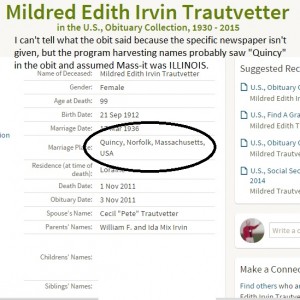
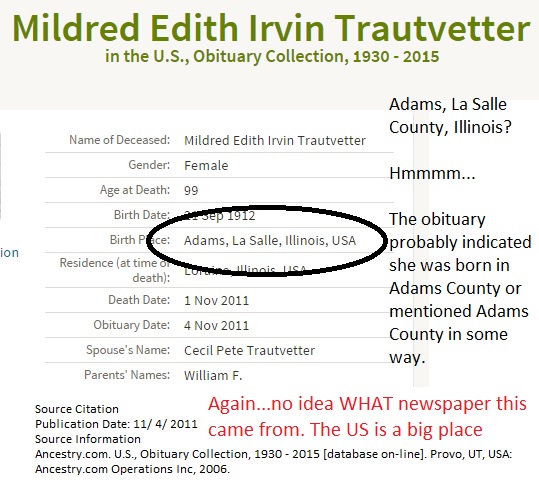
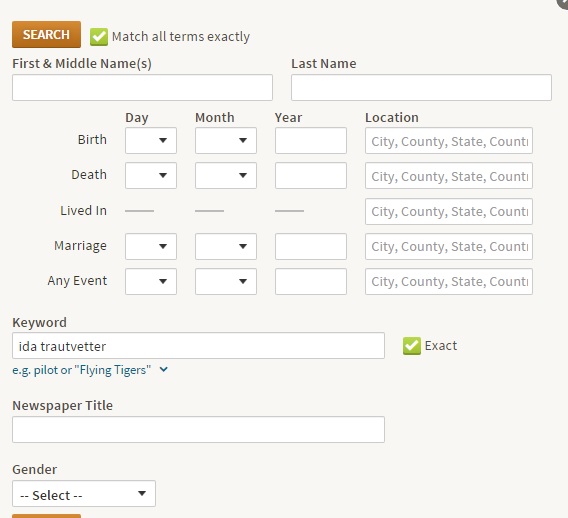
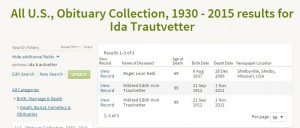

4 Responses
I have had some that do say to see the obituary, but at least 50%, the paper is not available. This may be a change in the location of the obituary, or it is a part of an archive, and it wasn’t an archive when it was it was indexed. A very frustrating situation.
I know when I have indexed obituaries for Family Search that the images are often of obituaries that were cut out of the newspaper and pasted onto a card. Often the name of the newspaper and the date of the obituary were not included. However, we were strictly instructed not to try to “guess” based on information in the obituary – if it was not clearly stated, that field was marked “blank.”
Don’t know if Ancestry has indexers or uses OCR for its obituaries.
Since they have the date of publication, I’m surmising that these obituaries were not clippings but were in online versions of newspapers.
The “Index only” of ancestry is another thing I won’t use. I have had things I put in my tree timeline as “probably”, “best guess” and “Suppose” and next thing I know they’re indexed at ancestry and come up in a search. My guess is they are mining family trees for information. The same trees that copy other trees that have copied One World Tree. Ancestry seems to be able to make up anything to match whatever you are looking for. Unless I can see the image of the document, nothing on ancestry is more than a possible hint that needs a LOT of research. If it’s an image it still needs to be proven. I won’t pay them a penny any more. And I certainly won’t believe everything they tell me.
It’s possible the death index came from a transcribed entry in someone’s tree without a source either in the tree or because ancestry didn’t cite the tree. Everyone knows trees have no mistakes and are 100% accurate. Another source of deaths seems to be the information on findagrave.
Use anything at ancestry at your own risk.